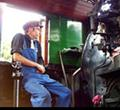The Fireman's Seat
By Robert Bell, Division 15, Assistant Superintendent



There are two divisions of model railroaders out there, “Rivet Counters” and “Freelancers”, sort of the Yen & Yang for our great hobby. Without either one, our hobby would suffer. The two create a balance in the model-railroading hobby. And, I believe that that there is a bit of both in most of us. Some of us may lean more towards one or the other, so let us take a closer look at each.
A “Rivet-Counter”, (taken to the extreme) may be defined as a modeler who follows a specific prototype railroad, during a certain year, month and/or day, maybe even a particular time of that day. He/she will attempt to replicate that point in history as closely as possible, down to what cars were parked on the street at a quarter-after-the-hour as the local freight rolled through town. These modelers that can tell you how many rivets were around the top row of rivets on the tender of a Denver & Rio Grande T-12 type 4-6-0, on May 9th of 1936; hence, the term “Rivet Counter”. These people are a GREAT source of information about whichever railroad suits their passion.
In the truest sense, a “Freelancer”, on-the-other-hand, follows no one, single prototype. This person may build or modify a locomotive to suit his fancy, knowing full well that there was NO exact prototype for his model. Or, this modeler may like to run trains around an oval of track nailed to a slab of plywood, just to see them go. He runs what he/she wants, how he wants and the fact that there are only two car lengths between the nose of his Mikado and his caboose 18 cars back doesn’t bother him at all. Hey, don’t laugh – my five-year old does it with his Thomas stuff. No, I am not saying that freelancers are a bunch of kids, after all, we all are. Aren’t we?
Oh, the rivet-counters have fun with the freelancers, “That ain’t prototypical!” they say. The freelancer will answer, “But, it could’ve been!” But, the reality is that even the rivet-counters are forced to make compromises in their modeling. When they shrink the distances between their towns, it is referred to as “selective compression”. That ain’t prototypical, either. But, after all an HO scale mile is a little over 60 feet, so this tends to be a necessity. Then they use another term, “modeler’s license”; to eliminate a town, reverse a curve, shorten a passing siding, or whatever. Again, not prototypical. I have a friend afflicted by “flumen duco”, (Latin for rivet counting), who just bought quite a few N&W hoppers, knowing that they were not the exact type of hopper that the N&W used. He knows this, accepts this, and says, “Hey, they just look good in a long train”. He’s happy, who can argue? Maybe there is hope for him, after all. Also, he will not spend the next 6 ½ years super-detailing them; he can run the flanges off the wheels instead.
There were (and are) real railroads that seemed to have had the freelancer in mind when they were built and operated. Steep grades, sharp curves, short mainlines and a mix of motive power made up a lot of the railroads here in WNC. The Murphy Branch of the Southern had grades that exceeded four-percent. The Graham County RR, that ran from Topton, NC to Robbinsville, NC, had both, a couple of Shay geared locomotives and a GE 70-ton diesel as late as the early 1970’s. My “serious” modeling in HOn3 is of a real narrow gauge railroad that, at least to me, is a perfect “freelance” prototype: The White Pass & Yukon Route in Alaska. However, the freelancer in me really comes out when I “rubber gauge” over to my On30 modeling.
Some of us model a railroad as it appeared at a certain point in time. Some modelers follow a specific prototype, but give their railroad a fictitious name. Others may model a fictitious branch line of their favorite railroad. And others just make it all up and end up the most famous of all model railroaders. Who? How about the late John Allen? The point is, we can all have fun doing what we love: model railroading.
In the April Fireman’s Seat, I’ll we’ll talk humor and our model railroads. Until then, remember: It’s
your club - get involved!
Let’s play trains!